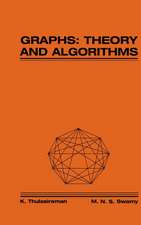Stochastic Models for Fault Tolerance: Restart, Rejuvenation and Checkpointing
Autor Katinka Wolteren Limba Engleză Paperback – 7 oct 2014
Wolter’s book details methods of redundancy in time that need to be issued at the right moment. In particular, she addresses the so-called "timeout selection problem", i.e., the question of choosing the right time for different fault-tolerance mechanisms like restart, rejuvenation and checkpointing. Restart indicates the pure system restart, rejuvenation denotes the restart of the operating environment of a task, and checkpointing includes saving the system state periodically and reinitializing the system at the most recent checkpoint upon failure of the system. Her presentation includes a brief introduction to the methods, their detailed stochastic description, and also aspects of their efficient implementation in real-world systems.
The book is targeted at researchers and graduate students in system dependability, stochastic modeling and software reliability. Readers will find here an up-to-date overview of the key theoretical results, making this the only comprehensive text on stochastic models for restart-related problems.
| Toate formatele și edițiile | Preț | Express |
|---|---|---|
| Paperback (1) | 312.87 lei 39-44 zile | |
| Springer Berlin, Heidelberg – 7 oct 2014 | 312.87 lei 39-44 zile | |
| Hardback (1) | 321.57 lei 39-44 zile | |
| Springer Berlin, Heidelberg – 6 iun 2010 | 321.57 lei 39-44 zile |
Preț: 312.87 lei
Preț vechi: 391.08 lei
-20% Nou
Puncte Express: 469
Preț estimativ în valută:
59.87€ • 62.43$ • 49.76£
59.87€ • 62.43$ • 49.76£
Carte tipărită la comandă
Livrare economică 17-22 martie
Preluare comenzi: 021 569.72.76
Specificații
ISBN-13: 9783642435003
ISBN-10: 3642435009
Pagini: 288
Ilustrații: XVI, 269 p.
Dimensiuni: 155 x 235 x 15 mm
Greutate: 0.41 kg
Ediția:2010
Editura: Springer Berlin, Heidelberg
Colecția Springer
Locul publicării:Berlin, Heidelberg, Germany
ISBN-10: 3642435009
Pagini: 288
Ilustrații: XVI, 269 p.
Dimensiuni: 155 x 235 x 15 mm
Greutate: 0.41 kg
Ediția:2010
Editura: Springer Berlin, Heidelberg
Colecția Springer
Locul publicării:Berlin, Heidelberg, Germany
Public țintă
ResearchCuprins
Basic Concepts and Problems.- Task Completion Time.- Restart.- Applicability Analysis of Restart.- Moments of Completion Time Under Restart.- Meeting Deadlines Through Restart.- Software Rejuvenation.- Practical Aspects of Preventive Maintenance and Software Rejuvenation.- Stochastic Models for Preventive Maintenance and Software Rejuvenation.- Checkpointing.- Checkpointing Systems.- Stochastic Models for Checkpointing.- Summary, Conclusion and Outlook.
Recenzii
From the reviews:
“Wolter’s textbook presents … three issues that will interest specialists in distributed systems and software design: restarting, rejuvenation, and checkpointing. … The book’s strength is its ability to systematically gather different models that are rarely presented together in one place. It is also admirable how clearly … the difficult material on reliability is presented. The work is intended for experienced readers … . The content is up to date; in fact, many of the analyses are quite new and based on Wolter’s own work.” (Piotr Cholda, ACM Computing Reviews, November, 2010)
“It is comprehensive and self-contained as it includes everything one needs to understand and apply the models and algorithms represented. Even the probability distributions used in those models are briefly, yet satisfactorily, explained in the appendices. All in all, I can recommend this book as a handbook not only to researchers and practitioners who work in this field, but also to students as a textbook.” (Fevzi Belli, Zentralblatt MATH, Vol. 1209, 2011)
“Wolter’s textbook presents … three issues that will interest specialists in distributed systems and software design: restarting, rejuvenation, and checkpointing. … The book’s strength is its ability to systematically gather different models that are rarely presented together in one place. It is also admirable how clearly … the difficult material on reliability is presented. The work is intended for experienced readers … . The content is up to date; in fact, many of the analyses are quite new and based on Wolter’s own work.” (Piotr Cholda, ACM Computing Reviews, November, 2010)
“It is comprehensive and self-contained as it includes everything one needs to understand and apply the models and algorithms represented. Even the probability distributions used in those models are briefly, yet satisfactorily, explained in the appendices. All in all, I can recommend this book as a handbook not only to researchers and practitioners who work in this field, but also to students as a textbook.” (Fevzi Belli, Zentralblatt MATH, Vol. 1209, 2011)
Notă biografică
Katinka Wolter is an assistant professor at Humboldt-University, Berlin, Germany, working with the on Computer Architecture and Communication Group since April 2002. She is principal investigator of two research projects funded by the German research council and teaches courses on performance analysis of communication systems and dependability evaluation. Prior to her current position, she was a visiting researcher at Hewlett-Packard Labs in Palo Alto, CA, USA. Her research interests include dependability evaluation of service-oriented architectures and wireless computer networks, as well as stochastic models for representing data in those systems and stochastic models for improving dependability through restart-based techniques.
Textul de pe ultima copertă
As modern society relies on the fault-free operation of complex computing systems, system fault-tolerance has become an indispensable requirement. Therefore, we need mechanisms that guarantee correct service in cases where system components fail, be they software or hardware elements. Redundancy patterns are commonly used, for either redundancy in space or redundancy in time.
Wolter’s book details methods of redundancy in time that need to be issued at the right moment. In particular, she addresses the so-called "timeout selection problem", i.e., the question of choosing the right time for different fault-tolerance mechanisms like restart, rejuvenation and checkpointing. Restart indicates the pure system restart, rejuvenation denotes the restart of the operating environment of a task, and checkpointing includes saving the system state periodically and reinitializing the system at the most recent checkpoint upon failure of the system. Her presentation includes a brief introduction to the methods, their detailed stochastic description, and also aspects of their efficient implementation in real-world systems.
The book is targeted at researchers and graduate students in system dependability, stochastic modeling and software reliability. Readers will find here an up-to-date overview of the key theoretical results, making this the only comprehensive text on stochastic models for restart-related problems.
Wolter’s book details methods of redundancy in time that need to be issued at the right moment. In particular, she addresses the so-called "timeout selection problem", i.e., the question of choosing the right time for different fault-tolerance mechanisms like restart, rejuvenation and checkpointing. Restart indicates the pure system restart, rejuvenation denotes the restart of the operating environment of a task, and checkpointing includes saving the system state periodically and reinitializing the system at the most recent checkpoint upon failure of the system. Her presentation includes a brief introduction to the methods, their detailed stochastic description, and also aspects of their efficient implementation in real-world systems.
The book is targeted at researchers and graduate students in system dependability, stochastic modeling and software reliability. Readers will find here an up-to-date overview of the key theoretical results, making this the only comprehensive text on stochastic models for restart-related problems.
Caracteristici
Includes supplementary material: sn.pub/extras












